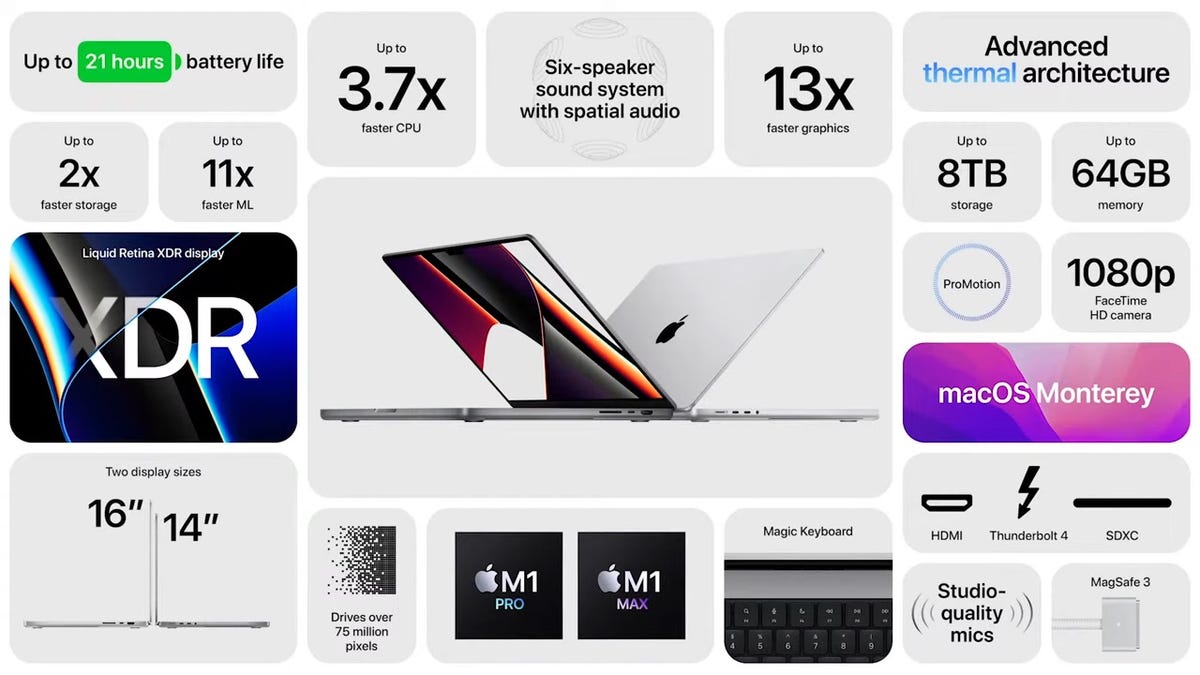We just got the first glimpse of Apple’s new MacBook Pros running the new M1 Pro and M1 Max Apple Silicon chips.
And they’re powerhouses.
The performance improvements compared to Apple’s previous-generation MacBook Pro laptops running Intel chips are stellar. We’re talking high-performance components delivering incredible performance and offering hours of extra battery life compared to its Intel predecessor.
It blows away the previous-gen MacBook Pro.
Must read: Apple finally admits it made a mistake and backtracks on three foolish MacBook Pro design decisions

MacBook Pro with M1 Max features
But here’s the thing, it also blows away PC laptops.
The amount of power — especially performance-per-watt — that Apple is reporting from the M1 Pro and M1 Max chips is stunning. Being able to get ten extra hours of run time from the 16-inch models is just unbelievable, and being able to do this on a system where cooling doesn’t sound like a jumbo jet taking off is a feat of engineering itself.
But it leaves me pondering.
What’s been going on in the PC laptop arena all this time?
Why haven’t Intel and Microsoft, and the PC OEMs, with all their might, not done something similar for the Windows market?
How has Apple been able to outperform all the big names in CPUs and GPUs and deliver such amazing performance-per-watt?
I think I have the answer, and Windows users are not going to like it.
The Windows PC market is all about the cheap end of the market.
The race to the bottom in the Windows laptop — and for that matter, the desktop — market has made it all about delivering tiny steps forward as cheaply as possible.
There is little room — let alone the financial incentive — to totally rewrite the architecture in a couple of years to reap these kinds of rewards.
Now, true, Apple controls the hardware and software, and as such can engineer tight integrations, the sorts of integrations that can squeeze every last drop of performance from the hardware.
But it’s not like Microsoft and Intel, and AMD and Nvidia and the OEMs don’t work together.
The truth is that the decades-long race to the bottom that has dominated the PC market has weakened it to the point where there’s not the stomach to put as much effort and R&D towards $2,000+ systems.
This is why creatives who process images and video and work with 3D modeling and AR/VR have been turning to Apple.
Sure, Apple has made mistakes. Even with the MacBook Pro.
MagSafe is back. More ports are back. The Touch Bar is gone.
But overall, Apple has been consistent about updating the products that professionals use.
If I wanted to switch to Windows tomorrow, I couldn’t find a system to compare to the new MacBook Pros.
It’s hard to find systems that compare favorably to my existing MacBook Pro.
I know. I’ve looked.
Don’t get me wrong. The Windows PC market is great for the masses. If you want a system for browsing the web, working with Microsoft Office documents, or typing up notes at college, some ridiculously cheap systems are available.
But if you need more, the Windows market doesn’t offer it. The legacy of the desktop, where performance-per-watt and good thermals didn’t matter, continues to haunt Windows laptops.
And while Windows-on-Arm chips offered a great deal of potential, the oomph needed to drag them into the mainstream doesn’t seem to be there.
The bottom line is that if you’re a Windows user that wants a modern, high-performance, long battery life, cool running laptop, you’re out of luck.
No one cares what you want.



